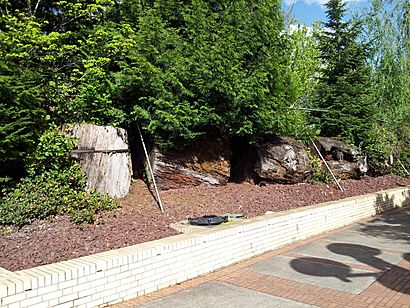Host Analog facts for kids
Quick facts for kids Host Analog |
|
|---|---|

The nurse log in 2015
|
|
| Artist | Buster Simpson |
| Year | 1991 |
| Type | Sculpture |
| Medium |
|
| Dimensions | 5.2 m × 27 m × 9.1 m (17 ft × 90 ft × 30 ft) |
| Location | Portland, Oregon, United States |
| 45°31′47″N 122°39′45″W / 45.52980°N 122.66241°W | |
Host Analog is a unique outdoor sculpture created in 1991 by artist Buster Simpson. You can find it outside the Oregon Convention Center in Portland, Oregon, United States.
Contents
What is Host Analog?
Host Analog is a special kind of art called a "living art installation." It uses a very old, 1,000-year-old Douglas fir log. This log was placed outside the Oregon Convention Center to help new plants grow.
A Home for New Life
The main idea behind Host Analog is to show how forests and cities are connected. The large log acts as a "nurse log." This means it provides a home and nutrients for young trees, called seedlings, to start growing. These seedlings come from Oregon's ancient forests.
Where the Log Came From
The huge Douglas fir log wasn't cut down. It was a "wind-fallen" tree, meaning it fell naturally during a storm. It came from the Bull Run River area, east of Portland. The log was cut into pieces, which makes it look a bit like old Roman ruins.
Keeping it Alive
To help the seedlings grow, a special system sprays mist onto the log. This mist comes from a stainless steel irrigation system. It sprays water for fifteen minutes at a time, keeping the log and plants moist.
Art and Nature Together
There are signs near the sculpture that explain the artwork. They even show pictures of how the log looked when it was first installed in 1991. The art piece shows how plants grow and change over time, even in a busy city. It reminds us about sustainability and how nature can thrive in urban areas. The sculpture is cared for by the Regional Arts & Culture Council.
Challenges and Choices
In 2000, a writer named Paul Kelsch shared an interesting challenge the artist, Buster Simpson, faced. While the young trees were growing well, other plants started to grow around the log too. These were "volunteer" plants that seeded themselves.
Artist's Dilemma
Buster Simpson wasn't sure what to do about these extra plants. Should he let them all grow, or should he remove some of them? This made him think about how much control an artist should have over nature in a living artwork. It's a question about balancing human design with natural processes.
Why it's Special
Host Analog is considered a very "unique" sculpture. It's often included in walking tours and guides for visitors exploring Portland. It's a great example of how art can make us think about our environment and our connection to nature.

